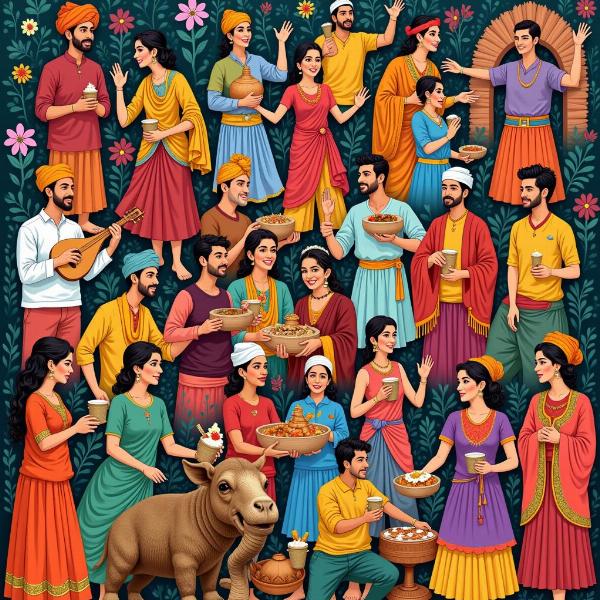Understanding the meaning of “minority” in Hindi is crucial for navigating India’s diverse social and political landscape. It’s not just a simple translation, but a concept deeply intertwined with legal rights, social dynamics, and cultural identity. This article explores the various nuances of “minority” in Hindi, its legal definition, social implications, and cultural significance.
Understanding “Minority” in the Indian Context
The term “minority” in Hindi is commonly translated as “अल्पसंख्यक” (alpsankhyak). However, the meaning goes beyond mere numerical representation. It encompasses groups that are numerically smaller than the majority population and often share distinct religious, linguistic, or cultural characteristics. This can include religious minorities like Muslims, Christians, Sikhs, Buddhists, Jains, and Parsis, as well as linguistic minorities. The Indian Constitution recognizes and protects the rights of these minorities.
Legal Definition of Minority in India
The Indian Constitution doesn’t explicitly define “minority.” However, Article 30 of the Constitution grants linguistic and religious minorities the right to establish and administer educational institutions of their choice. This provision safeguards their right to preserve and promote their language, culture, and script. Furthermore, various court judgments and government policies have further elaborated on the concept of “minority” within the Indian legal framework. The constitutional provision meaning in hindi further clarifies this complex landscape.
Who Decides Minority Status in India?
The central government is responsible for notifying minority communities at the national level. While states can also grant minority status to specific communities within their jurisdiction, there is ongoing debate about who has the ultimate authority to determine minority status.
Social Implications of Being a Minority in India
Being a minority in India can have profound social implications. While the Constitution guarantees equality and protection against discrimination, minority communities sometimes face challenges related to social inclusion, representation, and access to resources.
Minority Rights and Safeguards
The Indian government has implemented various safeguards to protect the rights of minorities, including affirmative action policies and special commissions for minorities. These measures aim to address historical disadvantages and promote equal opportunities. The hindi meaning of guardian emphasizes the protective role of the state in this context.
Cultural Significance of Minority Communities in India
Minority communities have significantly enriched India’s diverse cultural tapestry. Their unique languages, traditions, arts, and cuisines add vibrancy to the nation’s cultural landscape. Preserving and promoting these cultural expressions are crucial for fostering inclusivity and celebrating India’s multicultural heritage.
 Cultural Contributions of Minorities in India
Cultural Contributions of Minorities in India
Conclusion
Understanding the meaning of “minority” in Hindi requires acknowledging its legal, social, and cultural dimensions. While “अल्पसंख्यक” (alpsankhyak) serves as the literal translation, the term encompasses a complex interplay of identity, rights, and social dynamics within the Indian context. By recognizing and respecting the rights and contributions of minority communities, India can truly embrace its pluralistic ethos and strengthen its social fabric.
FAQ
- What is the Hindi word for minority? The common Hindi word for minority is “अल्पसंख्यक” (alpsankhyak).
- Does India have a legal definition of minority? The Indian Constitution doesn’t explicitly define “minority” but grants specific rights to religious and linguistic minorities.
- What are some examples of minority communities in India? Muslims, Christians, Sikhs, Buddhists, Jains, and Parsis are some religious minorities in India. Linguistic minorities also exist across the country.
- What rights do minorities have in India? Minorities have the right to establish and administer educational institutions, among other constitutional safeguards.
- What are some challenges faced by minorities in India? Despite constitutional safeguards, minorities sometimes face social discrimination and challenges in accessing resources.
- What is the role of the government in protecting minority rights? The government implements affirmative action policies and has established commissions to protect minority rights.
- How do minority communities contribute to Indian culture? Minority communities enrich India’s cultural diversity through their unique languages, traditions, arts, and cuisines.
Meaning-Hindi.in is your trusted partner for professional Hindi translation services. We specialize in various domains, including business, legal, technical, website localization, educational, and urgent translations. Our team of expert linguists ensures accurate and culturally sensitive translations to bridge communication gaps. Contact us today for all your Hindi translation needs! Email: [email protected], Phone: +91 11-4502-7584. Let Meaning-Hindi.in help you connect with the world through the power of language.